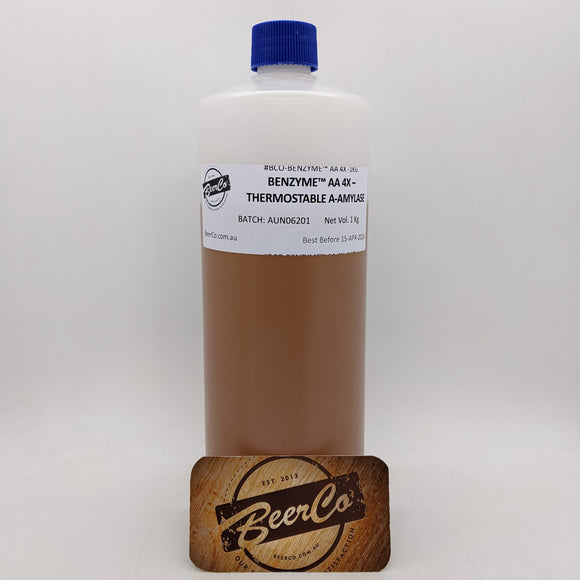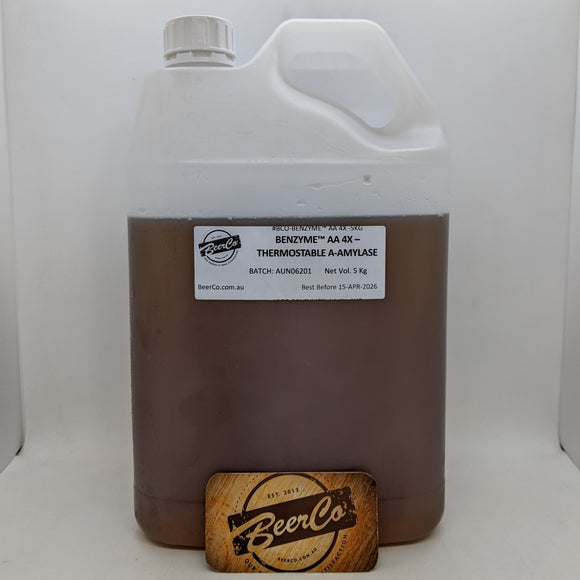Benzyme AA 4X is the sustainable solution for adjunct liquefaction and increased brewhouse capacity. Benzyme AA 4X is a double-concentrate of the high-performing Benzyme AA.
PRODUCT CHARACTERISTICS/PROPERTIES
Component name: Alpha-amylase
Activity: 240 KNU-S/g
Color: Amber
Physical form: Liquid
Approximate density (g/ml) 1.27
Color can vary from batch to batch. Color intensity is not an indication of enzyme activity.
Pack Sizes:
- 1 Kg Bottle
- 5 Kg Jerry Can (SAVE 20% OFF 1 Kg Price)
- 25 Kg Canister novozymes Termamyl® SC 4X
PRODUCT CHARACTERISTICS/PROPERTIES
Declared enzyme: Thermostable α-amylase
Declared Activity: 480KNU_S/g
Catalyzes the following reaction: Hydrolyzes 1,4-α-glucosidic linkages in amylose and amylopectin. Gelatinized starch is rapidly broken down into soluble dextrins and oligosaccharides
E.C/ I.U.B. no.: 3.2.1.1
Physical form: Brown liquid Production method The enzyme product is manufactured via fermentation of a microorganism not present in the final product. The production organism and enzyme effectiveness are improved by means of modern biotechnology
Density 1.25 g/ml
Benzyme AA 4X - Product Data Sheet
Benzyme AA 4X - Safety Data Sheet
Benefits
Increased adjunct inclusion
Adjuncts like corn, rice and sorghum starch have high gelatinization temperatures. Malt α-amylases become inactive at these temperatures. The result is inconsistent with starch degradation. That limits the proportion of these adjuncts you can include in your beers. This thermostable product delivers consistent liquefaction at high temperatures. That means you can increase adjunct inclusion in your beers.
Increase brewhouse capacity
This fast-acting product shortens mashing times. That allows you to increase brewhouse capacity while saving time and energy.
Consistent extract yield
A liquefaction step that uses only malt enzymes can lead to inconsistent starch degradation. This in turn leads to inconsistent extract yield. This heat-stable product delivers consistent liquefaction at high temperatures.
Flexible high gravity brewing
This product delivers the viscosity reduction you need to run your process at high grist. That allows you to reap the benefits of high-gravity fermentation. These include reduced energy and water consumption.
Potential energy savings
Decoction mashes are typically heated to a peak of 100°C.
That's partly so the physical action of boiling can break down starch molecules. This thermostable product degrades starch at 90°C to allow lower peak temperatures in your decoction vessels. Handling decoction mashes at lower temperatures leads to potential energy savings.
Enhance sustainability claims
This product's concentrated formulation allows you to reduce your number of deliveries. The result is lower handling costs and an improved sustainability profile.
For light beers
With this product, you can make light or low-calorie beers. It increases the degree of attenuation of the wort. That decreases the proportion of non-fermentable and short-chain dextrin material. The resulting beer will have up to 30% fewer calories than normal-attenuation beer with the same alcohol content.
For ultra-light beers
With the synergistic activity in this enzyme blend you can hit high attenuation targets in short reaction times. That allows you to produce ultra-light beers.
Brewing Application sheet
Cost-effective cereal cooking
Benzyme AA, Termamyl® AA 4X,
For high-gelatinizing adjuncts, a separate cooking step during mashing is required to secure sufficient gelatinization and liquefaction. Due to lower stability of malt α-amylases at the gelatinization temperatures of corn, rice and sorghum starch, a liquefaction step that uses only malt enzymes can lead to inconsistent starch degradation. This can result in several process and quality issues such as lower yields, less efficient wort separation and a haze increase in the final product.
Novozymes Termamyl® products are heat-stable amylases that offer easy and consistent liquefaction at high temperatures, providing many benefits and preserving full malt enzyme potential for the main mashing process.
Benefits
● Faster and more consistent liquefaction
● Lower mash viscosity, resulting in easier wort production
● No risk of resistant or retrograded starch formations, or insufficient saccharification
● Reduced processing costs through more efficient liquefaction, increased yield of up to 1%
● Improved flexibility of use of various cereal grain adjuncts
● Reduced energy consumption due to lower temperatures when handling decoction mashes
Performance
Starch-containing adjuncts and cereals must be processed in such a way that the starch is gelatinized and liquefied. Gelatinization refers to the swelling of the starch granules, whereas liquefaction is the de-branching process that breaks down the intermolecular bonds of starch (both amylose and amylopectin) in the presence
of excess water and applying heat in order to take up more water—this is also known as hydrolysis. The gelatinization process is necessary for liquefaction to reduce viscosity and to make starch susceptible to the enzymatic hydrolysis taking place during saccharification with malt enzymes and/or exogenous enzymes.
Liquefaction with Termamyl® is a simpler and faster process than liquefaction with malt enzymes. Termamyl® reduces cereal mash viscosity, thereby preventing the formation of retrograded starch. This secures the yield when using adjuncts as the liquefaction material as opposed to malt. The yield can be increased by more than 1%. While it is necessary for the malt α-amylase to work at its limit for temperature stability, Termamyl® maintains very high stability throughout the temperature ranges applied.
In addition to the aforementioned benefits, Termamyl® also enables manufacturers to lower the peak temperature of decoction vessels. Traditional decoction mashes are heated up to 100°C not only for gelatinization, but also to use the physical forces at this temperature to break down starch molecules. The thermostable α-amylases in Termamyl® already secure sufficient starch degradation at 90°C, making further temperature increases obsolete.


Figure 1 illustrates a normal mashing regime using a cereal cooker, with the addition of Termamyl® instead of malted barley. In figure 2, a normal viscosity graph is shown during the cereal cooking process, peaking during gelatinization.
Termamyl® is also a versatile solution in terms of mash thickness due to its exceptional liquefaction power, which is approx. 200–300 times higher per kg than that of malt. Thicker mashes can be operated without the risk of working with high viscosities.
This, in addition to the fact that 100 kg of malt is replaced by 0.2 kg Benzyme AA, enables smaller mashes, which is invaluable when balancing volumes and temperatures while working with high proportions of adjuncts. This versatility can also be used to increase brew house capacity. In addition to the benefits of working with thicker mashes, the malt is replaced by adjuncts with higher extract values.
The process is also more cost-effective, as all the malt can be used in the main mash. This safeguards the mashing operation and provides improved wort, which reaches the correct and higher side of the desired attenuation range and has an increased FAN content.
Usage
Dosage
The amount of Benzyme AA 4X added during mashing-in depends on adjunct material and quality.
| Dosage [kg/ton of adjunct] | Ca2+ requirements | |
| Benzyme AA 4X |
0.075–0.125 Kg / MT 0.075 - 0.125 g / Kg |
no dependency |
Nitrogen
Using higher amounts of adjuncts (>20%) may result in worts with insufficient free amino nitrogen (FAN). This can be counteracted by using a protease such as Neutrase® 0.8 L in the malt mash to extract more nitrogenous compounds from the malt.
Inactivation
Benzyme AA 4X can be deactivated during a typical wort boil.
Optimum pH and temperature
Figure 3 show Benzyme AA and Benzyme AA 4X activity as a function of pH and temperature.

More information can be found in the “Brewing Handbook”.
Product data
- Benzyme AA and Benzyme AA 4X (Quadruple strength)
- Declared enzyme - Thermostable α-amylase
- Catalyzes the following reaction: Hydrolyzes 1,4-α-glucosidic linkages in amylose and amylopectin. Gelatinized starch is rapidly broken down into soluble dextrins and oligosaccharides
- Declared activity 240 KNU_S/g & 480KNU_S/g
- E.C/ I.U.B. no.: 3.2.1.1
- Physical form - Brown liquid
- Production method - The enzyme product is manufactured via fermentation of a microorganism not present in the final product. The production organism and enzyme effectiveness are improved by means of modern biotechnology
- Density - 1.25 g/ml
Stability
Please see the Benzyme AA 4X - Product Data Sheet
Safety, handling and storage
This product contains enzymes. While enzymes are safe to use in consumer applications, they need correct handling in working environments to ensure workers’ safety.
Indeed, repeated inhalation of enzyme dust or aerosols resulting from improper handling may induce sensitization and may cause allergic type 1 reactions in sensitized individuals.
Please follow the precautionary handling recommendations below:
- Avoid breathing dust/fume/gas/mist/vapors/spray
- Avoid contact with eyes, skin, or clothing
- In case of inadequate ventilation wear respiratory protection
- IF INHALED: Remove person to fresh air and keep comfortable for breathing
- If experiencing respiratory symptoms: Call a POISON CENTER or a doctor
- Store in a dry place. Store in a closed container
- Dispose of contents/containers in accordance with local regulations
For more safety information, please watch the entire series of safety videos.


